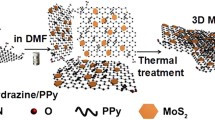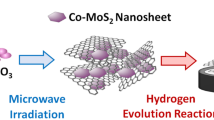Abstract
Layered transition metal dichalcogenides especially MoS2 is favorable to be the low-cost alternative to Pt-based electrocatalysts for water splitting. Defect-rich MoS2 nanosheets exhibiting enlarged interlayer spacing of 9.2 Å were synthesized via a solvothermal method, in which trithiocyanuric acid (TTCA) was used as a sulfur source. In addition, we synthesized MoS2 with L-cysteine for comparison. To improve the conductivity and quantity of active exposed sites of MoS2 nanosheets, the rGO nanosheets were introduced to hybridize with MoS2. With the addition of rGO, the MoS2/rGO hybrids exhibit different morphologies and larger interlayer spacing of 9.5 Å. Furthermore, the enhanced performance for hydrogen evolution reaction is attributed to the synergistic effect between the MoS2 nanosheets and rGO substrates. MoS2/rGO-2 possesses an onset overpotential of 118 mV, a small Tafel slope of 51 mV/dec, high double-layer capacitance (Cdl) of 15.27 mF/cm2, and superior cycling stability over 1000 cycles in acidic conditions.







Similar content being viewed by others
References
Cook TR, Dogutan DK, Reece SY, Surendranath Y, Teets TS, Nocera DG (2010) Solar energy supply and storage for the legacy and nonlegacy worlds. Chem Rev 110:6474–6502. https://doi.org/10.1021/cr100246c
Zhang L, Sun L, Huang Y et al (2017) Hydrothermal synthesis of N-doped RGO/MoSe2 composites and enhanced electro-catalytic hydrogen evolution. J Mater Sci 52:13561–13571. https://doi.org/10.1007/s10853-017-1417-7
Stamenkovic VR, Strmcnik D, Lopes PP, Markovic NM (2016) Energy and fuels from electrochemical interfaces. Nat Mater 16:57. https://doi.org/10.1038/nmat4738
Zou X, Zhang Y (2015) Noble metal-free hydrogen evolution catalysts for water splitting. Chem Soc Rev 44:5148–5180. https://doi.org/10.1039/C4CS00448E
Dasgupta NP, Liu C, Andrews S, Prinz FB, Yang P (2013) Atomic layer deposition of platinum catalysts on nanowire surfaces for photoelectrochemical water reduction. J Am Chem Soc 135:12932–12935. https://doi.org/10.1021/ja405680p
Chen Y, Yu G, Chen W et al (2017) Nonprecious electrocatalyst comprising borophene subunits for the hydrogen evolution reaction. J Am Chem Soc 139:12370–12373. https://doi.org/10.1021/jacs.7b06337
Huang H, Huang W, Yang Z et al (2017) Strongly coupled MoS2 nanoflake–carbon nanotube nanocomposite as an excellent electrocatalyst for hydrogen evolution reaction. J Mater Chem A 5:1558–1566. https://doi.org/10.1039/C6TA09612C
Wu J, Li B, Shao Y, Wu X, Sun Y (2019) Tuning the morphology and phase of MoSe2 by using a mixed solvent of water and dimethyl formamide and its enhanced electrocatalytic activity for hydrogen evolution reaction. J Mater Sci 55:2129–2138. https://doi.org/10.1007/s10853-019-04084-5
Gao M-R, Xu Y-F, Jiang J, Yu S-H (2013) Nanostructured metal chalcogenides: synthesis, modification, and applications in energy conversion and storage devices. Chem Soc Rev 42:2986–3017. https://doi.org/10.1039/C2CS35310E
Tan C, Zhang H (2015) Epitaxial growth of hetero-Nanostructures based on ultrathin two-dimensional nanosheets. J Am Chem Soc 137:12162–12174. https://doi.org/10.1021/jacs.5b03590
Li Y, He B, Liu X et al (2019) Graphene confined MoS2 particles for accelerated electrocatalytic hydrogen evolution. Int J Hydrogen Energy 44:8070–8078. https://doi.org/10.1016/j.ijhydene.2019.02.089
Lukowski MA, Daniel AS, Meng F, Forticaux A, Li L, ** S (2013) Enhanced hydrogen evolution catalysis from chemically exfoliated metallic MoS2 nanosheets. J Am Chem Soc 135:10274–10277. https://doi.org/10.1021/ja404523s
Wang H, Lu Z, Kong D, Sun J, Hymel TM, Cui Y (2014) Electrochemical tuning of MoS2 nanoparticles on three-dimensional substrate for efficient hydrogen evolution. ACS Nano 8:4940–4947. https://doi.org/10.1021/nn500959v
Liu Y, Liu J, Li Z et al (2018) Exfoliated MoS2 with porous graphene nanosheets for enhanced electrochemical hydrogen evolution. Int J Hydrogen Energy 43:13946–13952. https://doi.org/10.1016/j.ijhydene.2018.02.039
Hinnemann B, Moses PG, Bonde J et al (2005) Biomimetic hydrogen evolution: MoS2 nanoparticles as catalyst for hydrogen evolution. J Am Chem Soc 127:5308–5309. https://doi.org/10.1021/ja0504690
Merki D, Fierro S, Vrubel H, Hu X (2011) Amorphous molybdenum sulfide films as catalysts for electrochemical hydrogen production in water. Chem Sci 2:1262–1267. https://doi.org/10.1039/C1SC00117E
Wu Z, Fang B, Wang Z et al (2013) MoS2 nanosheets: a designed structure with high active site density for the hydrogen evolution reaction. ACS Catal 3:2101–2107. https://doi.org/10.1021/cs400384h
Yan Y, **a B, Ge X, Liu Z, Wang J-Y, Wang X (2013) Ultrathin MoS2 nanoplates with rich active sites as highly efficient catalyst for hydrogen evolution. ACS Appl Mater Interfaces 5:12794–12798. https://doi.org/10.1021/am404843b
Zhao Y, Bo X, Guo L (2017) An efficient electrocatalysts for the hydrogen evolution reaction based on molybdenum dioxide nanoparticles embedded porous graphene nanocomposite. Int J Hydrogen Energy 42:5569–5576. https://doi.org/10.1016/j.ijhydene.2016.07.198
Kibsgaard J, Tuxen A, Knudsen KG et al (2010) Comparative atomic-scale analysis of promotional effects by late 3D-transition metals in MoS2 hydrotreating catalysts. J Catal 272:195–203. https://doi.org/10.1016/j.jcat.2010.03.018
Merki D, Vrubel H, Rovelli L, Fierro S, Hu X (2012) Fe Co, and Ni ions promote the catalytic activity of amorphous molybdenum sulfide films for hydrogen evolution. Chem Sci 3:2515–2525. https://doi.org/10.1039/C2SC20539D
Zhang H, Li Y, Xu T et al (2015) Amorphous Co-doped MoS2 nanosheet coated metallic CoS2 nanocubes as an excellent electrocatalyst for hydrogen evolution. J Mater Chem A 3:15020–15023. https://doi.org/10.1039/C5TA03410H
Bonde J, Moses PG, Jaramillo TF, Nørskov JK, Chorkendorff I (2009) Hydrogen evolution on nano-particulate transition metal sulfides. Faraday Discuss 140:219–231. https://doi.org/10.1039/B803857K
Chen Z, Cummins D, Reinecke BN, Clark E, Sunkara MK, Jaramillo TF (2011) Core–shell MoO3–MoS2 nanowires for hydrogen evolution: a functional design for electrocatalytic materials. Nano Lett 11:4168–4175. https://doi.org/10.1021/nl2020476
Lu Z, Zhang H, Zhu W et al (2013) In situ fabrication of porous MoS2 thin-films as high-performance catalysts for electrochemical hydrogen evolution. Chem Commun 49:7516–7518. https://doi.org/10.1039/C3CC44143A
Zheng X, Xu J, Yan K, Wang H, Wang Z, Yang S (2014) Space-confined growth of MoS2 nanosheets within graphite: the layered hybrid of MoS2 and graphene as an active catalyst for hydrogen evolution reaction. Chem Mater 26:2344–2353. https://doi.org/10.1021/cm500347r
Kibsgaard J, Chen Z, Reinecke BN, Jaramillo TF (2012) Engineering the surface structure of MoS2 to preferentially expose active edge sites for electrocatalysis. Nat Mater 11:963. https://doi.org/10.1038/nmat3439
**e J, Zhang H, Li S et al (2013) Defect-rich MoS2 ultrathin nanosheets with additional active edge sites for enhanced electrocatalytic hydrogen evolution. Adv Mater 25:5807–5813. https://doi.org/10.1002/adma.201302685
**e J, Zhang J, Li S et al (2013) Controllable disorder engineering in oxygen-incorporated MoS2 ultrathin nanosheets for efficient hydrogen evolution. J Am Chem Soc 135:17881–17888. https://doi.org/10.1021/ja408329q
Yang J, Voiry D, Ahn SJ et al (2013) Two-dimensional hybrid nanosheets of tungsten disulfide and reduced graphene oxide as catalysts for enhanced hydrogen evolution. Angew Chem Int Ed 52:13751–13754. https://doi.org/10.1002/anie.201307475
Chang Y-H, Lin C-T, Chen T-Y et al (2013) Highly efficient electrocatalytic hydrogen production by MoSx grown on graphene-protected 3D Ni foams. Adv Mater 25:756–760. https://doi.org/10.1002/adma.201202920
Li F, Zhang L, Li J et al (2015) Synthesis of Cu–MoS2/rGO hybrid as non-noble metal electrocatalysts for the hydrogen evolution reaction. J Power Sources 292:15–22. https://doi.org/10.1016/j.jpowsour.2015.04.173
Li Y, Wang H, **e L, Liang Y, Hong G, Dai H (2011) MoS2 nanoparticles grown on graphene: an advanced catalyst for the hydrogen evolution reaction. J Am Chem Soc 133:7296–7299. https://doi.org/10.1021/ja201269b
Gao M-R, Chan MKY, Sun Y (2015) Edge-terminated molybdenum disulfide with a 9.4-Å interlayer spacing for electrochemical hydrogen production. Nat Commun 6:7493. https://doi.org/10.1038/ncomms8493
Tang Y-J, Wang Y, Wang X-L et al (2016) Molybdenum disulfide/nitrogen-doped reduced graphene oxide nanocomposite with enlarged interlayer spacing for electrocatalytic hydrogen evolution. Adv Energy Mater 6:1600116. https://doi.org/10.1002/aenm.201600116
Liu A, Zhao L, Zhang J, Lin L, Wu H (2016) Solvent-assisted oxygen incorporation of vertically aligned MoS2 ultrathin nanosheets decorated on reduced graphene oxide for improved electrocatalytic hydrogen evolution. ACS Appl Mater Interfaces 8:25210–25218. https://doi.org/10.1021/acsami.6b06031
**e K, Yuan K, Li X et al (2017) Superior potassium ion storage via vertical MoS2 “Nano-Rose” with expanded interlayers on graphene. Small 13:1701471. https://doi.org/10.1002/smll.201701471
Acknowledgements
This work was financially supported by the National Natural Science Foundation of China (No. 21878031), the Liaoning Province Natural Science Foundation (No. 20180550770) and the Liaoning Revitalization Talents Program (No. XLYC1802124).
Author information
Authors and Affiliations
Corresponding authors
Ethics declarations
Conflict of interest
There are no conflicts to declare.
Additional information
Publisher's Note
Springer Nature remains neutral with regard to jurisdictional claims in published maps and institutional affiliations.
Electronic supplementary material
Below is the link to the electronic supplementary material.
Rights and permissions
About this article
Cite this article
Lin, Q., Dong, X., Wang, Y. et al. Molybdenum disulfide with enlarged interlayer spacing decorated on reduced graphene oxide for efficient electrocatalytic hydrogen evolution. J Mater Sci 55, 6637–6647 (2020). https://doi.org/10.1007/s10853-020-04478-w
Received:
Accepted:
Published:
Issue Date:
DOI: https://doi.org/10.1007/s10853-020-04478-w




